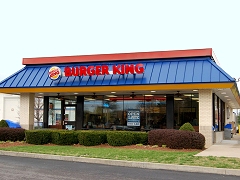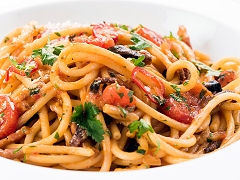Taking advantage of larger portion sizes when eating out may only cost a few pennies more, but dramatically increase the amount of calories you consume and substantually add to your waistline.
Just a few pennies more, but a lot more food

From Wallet to Waistline, a new report by the National Alliance for Nutrition and Activity (NANA), compares the costs and calories of upgrading to larger portion sizes at fast-food restaurants, convenience stores and other retail food establishments, and found that upgrading to larger serving sizes often increases the price only modestly, but substantially increases the calorie and fat content of your food. 'Value marketing' (providing you with more food for less money) is a technique used by food companies that is profitable for them, but also encourages you to overeat and put on weight.
Americans are constantly induced to spend a little more money to get a lot more food. said Margo Wootan, director of nutrition policy at the Center for Science in the Public Interest (CSPI). Getting more for your money is ingrained in the American psyche.
Encouraging you to eat

In addition to using price to encourage the purchase of larger portion sizes, fast-food restaurants, in particular, actively encourage you to 'upgrade' to larger sizes with point-of-purchase displays and verbal sales prompts form employees. Fast food establishments may also try to encourage you to combine your meal with high-calorie soft drinks and side dishes like French Fries - a technique known in the food industry as bundling.
Fattening upgrades

The report found that:
* Upgrading from a 3-ounce Minibon to a Classic Cinnabon costs only 24% more, yet delivers 123% more calories. The larger size also provides almost three-quarters of a day's worth of saturated fat.
* Switching from 7-Eleven's Gulp to a Double Gulp costs 42% more, but provides 300% more calories. Those 37 extra cents deliver 450 extra calories-more than you'd get in a McDonald's Quarter Pounder!
* It costs 8 cents more to purchase a McDonald's Quarter Pounder with Cheese, small French fries, and small Coke (890 calories) separately than it costs to buy the Quarter Pounder with Cheese large Extra Value Meal, which comes with a large fries and large Coke (1,380 calories). McDonald's actually charges customers more to buy a smaller, lower-calorie meal. Wootan said.
* Moving from a small to a medium bag of movie theater popcorn costs about 71 cents- but adds 500 calories. A 23% increase in price provides 125% more calories and two days' worth of saturated fat. (And that's unbuttered popcorn!)
According to the report, 'bundling' is responsible for some of the largest increases in calorie content, and fountain drinks proved to be the best bargain of all. They cost the least to upgrade and deliver the biggest calorie boosts.
'If you walked into a McDonald's in the 1950s and ordered a burger, fries and a 12-ounce coke, you'd have bought a meal with about 590 calories,' said Carol Tucker Foreman, director of the Food Policy Institute at the Consumer Federation of America. 'Today a popular super-sized meal may contain 1,000 calories more. As a result, we're super sizing our kids and super sizing ourselves.'


